#CCM organization
Explore tagged Tumblr posts
Text
Best Practices for Implementing CCM Managed Services with OpenText Exstream

Implementing a customer communications management (CCM) solution like OpenText™ Exstream™ can be transformative for your organization, albeit one that requires careful planning and execution. One effective way to streamline the process and increase the likelihood of a successful deployment is by leveraging the support of managed services. Here are some best practices to guide your implementation journey:
1. Define Clear Objectives and Scope
Align with strategy: Ensure your CCM objectives align with your organization's overall business strategy. Precise alignment helps in effectively allocating resources and setting priorities. Understanding how the CCM system fits your broader goals will guide decision-making throughout the implementation process.
Engage stakeholders: Involve critical departments and stakeholders early on. Their insights will be crucial in addressing needs, concerns, and potential challenges. Engaging a diverse group of stakeholders helps ensure that the CCM system meets the varying needs across your organization.
Prioritize functions: Start with the essential functionalities that deliver immediate value. A phased approach allows for focusing on core capabilities initially, with the flexibility to expand functionalities in the future as your needs evolve.
2. Choose the Right Managed Services Provider
Assess experience: Select a managed services provider with a proven track record in managing CCM solutions within your industry. Their experience can help navigate complex scenarios and make sure best practices are followed.
Cultural fit: Ensure the provider's values and working style align with your organization's culture. A good cultural fit can lead to smoother collaboration and a more seamless implementation process.
3. Leverage Existing Infrastructure and Data
Evaluate data quality: Assess the quality of your existing data before integration. Clean and complete data is crucial for effective communications and minimizing issues post-implementation.
Optimize integration: Develop efficient integration processes to connect OpenText Exstream with your existing systems. This reduces manual data handling, minimizes errors, and enhances overall efficiency.
Data governance: Implement robust policies to ensure data integrity and security. Effective data governance is essential for maintaining trust and compliance.
4. Prioritize Data Security and Compliance
Risk assessment: Conduct a thorough risk assessment to identify potential security threats. Prioritize and implement appropriate measures to mitigate these risks.
Robust controls: Utilize access controls, encryption, and regular audits to safeguard sensitive data. Ensuring strong security measures protects against data breaches and unauthorized access.
Regulatory compliance: Stay informed about data privacy laws and regulations. Compliance is critical to avoid legal issues and maintain your organization's reputation.
5. Test Thoroughly and Optimize
Testing plan: Develop a comprehensive testing plan that covers various scenarios, roles, and use cases. Thorough testing helps identify and resolve issues before the system goes live.
User acceptance testing (UAT): Engage end users in the testing process to validate the usability and functionality of the CCM system. Their feedback is invaluable for confirming the system meets practical needs and expectations.
Performance monitoring: Continuously monitor the system's performance after deployment. Regularly review and adjust configurations to optimize performance and address any emerging issues.
6. Ensure Effective Change Management
Communicate proactively: Maintain open lines of communication with stakeholders throughout the implementation process. Keeping everyone informed builds support and reduces resistance to change.
Ongoing training: Provide continuous training to help users adapt to the new system. Practical training ensures that users are comfortable and proficient with the new tools and processes.
Address resistance: Identify and address any resistance or concerns proactively. Understanding and addressing these issues can facilitate a smoother transition and promote acceptance.
7. Consider Cloud-based Implementation
Evaluate cloud providers: When considering a cloud-based implementation, choose a provider based on security, reliability, scalability, and cost. The right cloud provider can enhance your CCM system's performance and flexibility.
Hybrid approaches: Explore hybrid or multi-cloud options if they align better with your organizational needs. Hybrid approaches can provide greater flexibility and scalability.
Migration strategy: Develop a clear migration strategy for a smooth transition to the cloud. Planning and preparation are crucial to minimizing disruptions during the migration process.
By following these best practices, you can effectively implement OpenText Exstream with managed services and enhance your customer communications strategies. A well-executed implementation will not only streamline your processes but also deliver significant value to your organization and its customers.
for blog details click here.
#OpenTextExstream#ccm managed services#customer communicationsn management#CCM solution#belwo#CCM organization#Best customer communication management organization
1 note
·
View note
Text
matthew lore: childhood friends & teammates
AKA a vaguely chronological list of current NHL players Matthew knew before he ever played an NHL game
This is already a massive list, so in an effort to keep it as short and organized as possible, I have bolded the names of guys who appear in multiple categories and have only included those who have played at least a full season’s worth of games in the NHL.
For a comprehensive list of his teammates that have ever played an NHL game, this invaluable tool will provide you that information dating back to his first season in the NTDP (2013-2014).
CASEY FITZGERALD gets to go first and uncategorized, because he’s known Matthew longer than anyone else on this list, seems to be the cousin he’s closest to, and is one of the three childhood teammates that became one of Matthew’s NHL teammates. (And roommate!)
THE ST. LOUIS BOYS
LUKE KUNIN is THE guy. Their families are friends (Matthew’s whole fam was at Luke’s wedding, Luke’s whole fam was at Brady’s), and they were teammates for fourteen straight seasons before finally getting separated after their time at the NTDP, which is so long Luke's literally known Matthew longer than Taryn has.
Of the six St. Louis guys drafted in 2016, Luke and Matthew were the only ones born in 1997, so the following have all played with Matthew significantly less than Luke.
CCM Motown Classic 2005
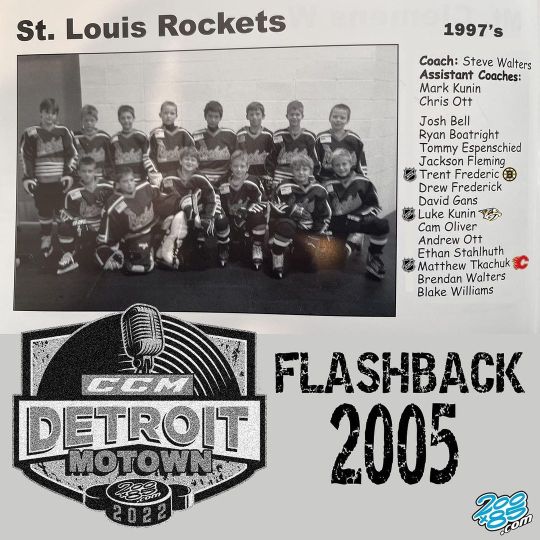
TRENT FREDERIC From what I can find, Trent only played with Matthew during the 2005-2006 St. Louis Rockets season, but he played with Brady and was coached by Keith in the same Junior Blues hockey program, was one of the family friends that got to come around and play mini sticks with David Backes as a kid, and his time at the NTDP overlapped with Matthew’s in the 2014-2015 season (Trent U17, Matthew U18).
2010 Quebec International Pee-Wee Hockey Tournament

CLAYTON KELLER played in the 2010 Quebec International Pee-Wee Tournament with Matthew and likely more but trying to find youth hockey rosters from before 2015 is a herculean task. But he was one of those U17 guys that got to play up with the U18s his first year in the NTDP and played with Matthew for 16 games and then went on to win gold together at the U18 Men's World Championship in 2015.

LOGAN BROWN Other than the 2010 tournament, Logan seems to have played more with Brady than he did with Matthew, and wasn’t in the NTDP like the other guys, but does train with them in the summer.


2011-2012 U15 AAA Junior Blues Team
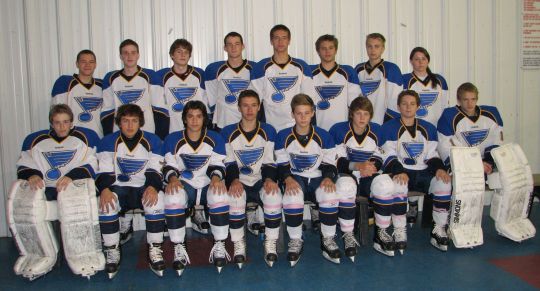
2013 U16 National Tier One tournament champions

JOSEPH WOLL Unlike the other St. Louis boys, Joseph seems to have played exclusively with Brady, but his time at the NTDP overlapped with Matthew’s the same as Trent’s did. It’s unclear if he trains at the same place as the others during the offseason, but along with the rest of the 2016 St. Louis Draftees, his signed draft day photo is framed in Matthew’s bedroom at his parents' house because of course it is.
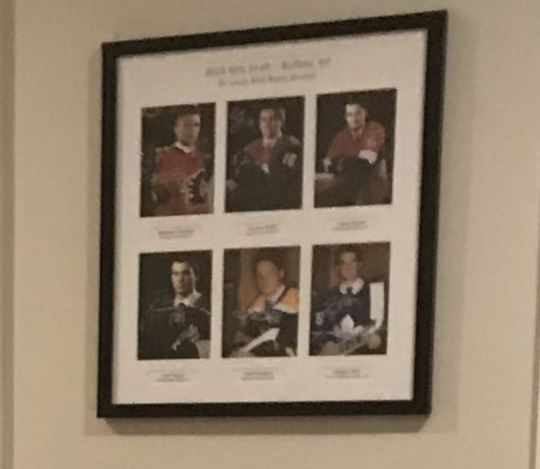
THE 1997 JUNIOR BRUINS

This Athletic article is about all the NHL players who played for the 1997 Junior Bruins tournament team over the years, but from what I can find, Matthew only played on the 2010 team with Casey Fitzgerald, NOAH HANIFIN, CHARLIE MCAVOY, COLIN WHITE, and the ever present, Luke Kunin.
Matthew is still close friends with all these guys, but Noah in particular is a Noted Best Friend and with him being from Boston and the Tkachuks having a house in Cape Cod, their summers overlap a lot even when they aren’t teammates.

With Casey, he and Colin White are the only childhood teammates to play with Matthew in the NHL.
THE NTDP BOYS
Okay, this section is where it gets a little chaotic so I split it between the guys who played with Matthew and those he went to school and was familiar with because their time at the NTDP overlapped.
2013-2014 NTDP Teammates Including the gold medal teams for the 2014 U17 World Hockey Challenge & the 2015 U18 World Championship
ZACH WERENSKI
Repeat: Noah Hanifin

2013-2015 NTDP Teammates Including the gold medal teams for the 2014 U17 World Hockey Challenge & the 2015 U18 World Championship
JORDAN GREENWAY
CALEB JONES
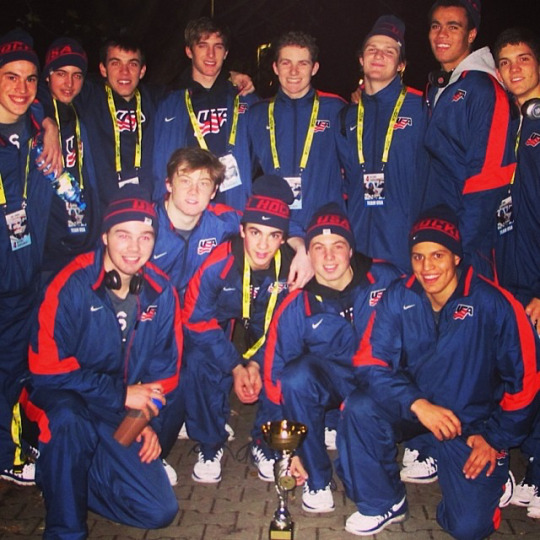

CHRISTIAN FISCHER spent his youth hockey years playing against Matthew, and when they both headed off to the NTDP, their parents split billet duties. He is one of Matthew’s best friends, attended Matthew’s draft, and even went with Matthew to Brady’s draft.

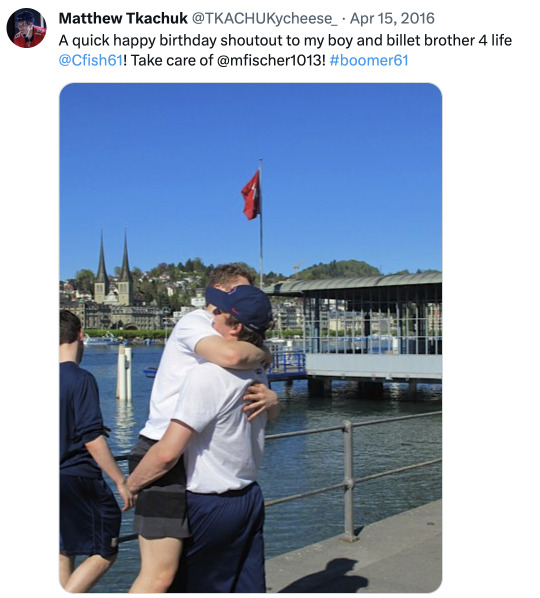
JACK ROSLOVIC was linemates with Matthew (and Auston) in the 2014-2015 season and when Matthew went to the 2015 Draft to support all his 1996 boys, Jack was the one he chose to sit with. The next summer, Jack returned the favor (see photo with Christian at Matthew's draft above).


AUSTON MATTHEWS is another family friend. He was Matthew’s center in 2014-2015 and when he broke his leg the previous year, Keith got a bunch of NHL guys to reach out to Auston , and he’s the one who gave us the best story about Matthew texting his own highlights to his friends.

Repeats: Luke Kunin, Casey Fitzgerald, Colin White, Charlie McAvoy


2014-2015 NTDP Teammates Including the 2015 U18 World Championship
TAGE THOMPSON
TROY TERRY
Repeat: Clayton Keller: played up 16 games as a U17

Teammates for a handful of games:
TOMMY NOVAK: 2 games for 2013-2014 U17 team
JAKE OETTINGER: 3 games for 2014-2015 U18 Team, and was part of the team but did not PLAY in the 2015 U18 World Championship
MAX JONES: 2 games for 2014-2015 U18 TeamRYAN DONATO played 4 games for 2014-2015 U18 Team and is now part of the extended Tkachuk family due to Emma, Brady’s wife, being his cousin.
NTDP Overlaps
2013-2014 U18s:
JACK EICHEL
ALEX TUCH
DYLAN LARKIN
2014-2015 U17s:
JOEY ANDERSON
ADAM FOX
RYAN LINDGREN
KAILER YAMAMOTO
repeats: Max Jones, Clayton Keller, Joseph Woll, Trent Frederic, Jake Oettinger

2015-2016 LONDON KNIGHTS
ROBERT THOMAS is practically a third Tkachuk brother at this point. But before Robbie lived with the Tkachuks, his own parents opened their home to Matthew while he trained at Gary Roberts’ the summer of his draft. Then when Robbie’s rookie season came along, it was Matthew who then suggested Robbie live with his parents too.

MITCH MARNER
EVAN BOUCHARD
VICTOR METE
Repeats: Max Jones, Christian Dvorak


2016 WORLD JUNIORS (bronze medal team)
NICK SCHMALTZ
BRANDON CARLO
BROCK BOESER
WILL BORGEN
ALEX DEBRINCAT
ANDERS BJORK
ALEX NEDELJKOVIC
SONNY MILANO
Repeats: Auston Matthews, Zach Werenski, Christian Dvorak, Colin White, Ryan Donato, Charlie McAvoy


HONORABLE MENTIONS
None of the Hughes brothers played with or overlapped with Matthew in the NTDP, but the two families are friends, and as far as I can tell, first met in 2010 when Quinn played on Brady’s Junior Bruins tournament team.
QUINN HUGHES is Brady’s best friend from billeting with him and Keith while in the NTDP and is on this list because Jack called Brady and Matthew QUINN’S BOYS, their families are friends and met at the latest, in 2010 when Quinn played on Brady's Junior Bruins tournament team. On top of that, Quinn he once included Matthew in his answer about watching Chris Tanev play after he got traded to the Flames for no reason at all other than to say he likes to watch him play too.

And last, but certainly not least, is CONNOR MCDAVID.
Matthew spent multiple summers, including the summer before his rookie season, training with Connor at Gary Roberts’ and the two of them are what I like to call STAR CROSSED TEAMMATES. Not only does Matthew swear the Oilers almost drafted him—and there’s certainly enough reports and predictions from before his draft to back up that being the plan—but Connor could’ve been a 1997 Junior Bruin if Brain McDavid wasn’t out to get me.


#matthew lore#matthew tkachuk#i am not tagging every guy in this it's just too many#rip to all the photos i curated for this post that could not fit
257 notes
·
View notes
Text
If you’ve ever wondered why it seems like every other station on your dial is Christian rock, EMF [the Educational Media Foundation] is a big part of your answer. From its headquarters in a Nashville suburb (the organization is slowly relocating from its longtime home of California), EMF plays the generic sounds of contemporary Christian music, or “CCM.” It is a genre that everyone from artists and critics to church leaders have decried as being somewhere between “the absolute worst” and “doctrinally unsound.” But the Educational Media Foundation has quietly become the country’s fastest-growing radio chain and second-largest station owner in the country, bested only by iHeartRadio. With hundreds of cookie-cutter stations branded as “K-LOVE,” as well as its smaller chain of “Air1” stations, EMF broadcasts on more than 1,000 signals across all 50 states and some U.S. territories, reaching an estimated 18 million listeners a week. On the surface, EMF’s broadcasts are glaringly apolitical. They opt instead for their trite brand of Christian rock, all teed off by the same, small cast of nationally syndicated, Anywhere-USA DJs who smile through everything from squeaky-clean jokes about the drink sizes at Starbucks to prayers asking God to watch over those who have donated to the organization. But behind its politically neutral facade, the organization — and the CCM industry more broadly — appears to be an inherently conservative project. Many right-wing Christian culture bearers have long believed in the “Breitbart Doctrine” — the idea that, to change politics, you must first change culture — and have fought for decades to build a parallel popular culture free of sharp edges, hard questions, or representations of lives that veer from the straight and narrow.
[...] But EMF’s story isn’t just about bad music taking over the airwaves in service of a cultural vision that is overwhelmingly white, straight, and artistically regressive. It’s also the story of the near-demise of local radio — a longtime haven for new music, artistic outcasts, and political dialogue — at the hands of a tax-avoiding not-for-profit organization that appears to operate like a very-much-for-profit media mega-corporation. For decades, EMF has hidden behind a veneer of uncoolness while honing a signature technique: At big commercial stations and small, beloved community-radio stations alike, they’ve offered the owners an undeniable sum of money, wiped out the local presence, and replaced it with unmanned transmitters.
8 notes
·
View notes
Text
On the surface, EMF’s broadcasts are glaringly apolitical. They opt instead for their trite brand of Christian rock, all teed off by the same, small cast of nationally syndicated, Anywhere-USA DJs who smile through everything from squeaky-clean jokes about the drink sizes at Starbucks to prayers asking God to watch over those who have donated to the organization. But behind its politically neutral facade, the organization — and the CCM industry more broadly — appears to be an inherently conservative project. Many right-wing Christian culture bearers have long believed in the “Breitbart Doctrine” — the idea that, to change politics, you must first change culture — and have fought for decades to build a parallel popular culture free of sharp edges, hard questions, or representations of lives that veer from the straight and narrow. The world of CCM, in turn, “reflects the values of the religious right,” says religious-studies historian and author of God Gave Rock and Roll to You: A History of Contemporary Christian Music Leah Payne, by providing “suburban families with safe Christian listening experiences in the car.” And while EMF stations may not have the “attention-getting, rage-inducing content” of an explicitly political outlet like Fox News, she says, “K-LOVE is the softer side of that conservatism.” Today, the organization’s nationwide network of radio stations plays mostly white, male artists. Though it professes to broadcast “Christian music,” it largely steers clear of genres like religious rap or gospel, as well as any Christian rock that grapples too heavily with doubt or hardship. Christian artists who have wavered in their faith have quietly been dropped from EMF’s playlists; several queer Christian artists have lost work and airtime on CCM radio after coming out. (Through a representative, EMF declined to be interviewed for this story and did not respond to requests for comment.)
My mama listens to K-LOVE all the fucking time and it is the most generic half-assed mealymouthed bullshit I've ever heard 24-7. Now I know who to blame.
7 notes
·
View notes
Text
Chronic Care Management | CPT Codes & Requirements | Healtharc
Chronic Care Management (CCM) services are non-face-to-face services offered to Medicare beneficiaries with two or more chronic diseases that are expected to last at least 12 months or until the patient’s death. The Centers for Medicare and Medicaid Services (CMS) recognize that CCM services are essential components of primary care that promote better health and lower total healthcare expenditures. CCM allows physicians and healthcare organizations to provide ongoing therapy to patients via remote interactions. Medicare will reimburse for the CCM program if at least 20 minutes of patient service is provided every month. To be eligible for CCM, a patient must have two or more chronic diseases and the physician must report any chronic ailments one is experiencing 12 months before the CCM participation.
1 note
·
View note
Text
Component Content Management Systems Market Gaining Momentum with AI and Semantic Content Integration

Market Overview
The Component Content Management Systems (CCMS) market is evolving rapidly, becoming a vital asset for businesses seeking to streamline content development and management across various formats and platforms. Unlike traditional content management systems, a CCMS enables content to be broken down into reusable, modular components—improving consistency, efficiency, and collaboration in large-scale documentation and publishing environments. With increasing digitization, globalization, and the demand for localized content, industries such as manufacturing, software development, publishing, and e-learning are turning to CCMS solutions to manage complex and multilingual content workflows.
Market Size, Share & Demand Analysis
The Component Content Management Systems market is on a steady growth trajectory. Enterprises—particularly those involved in technical documentation and regulated industries—are showing significant demand for sophisticated content workflows, metadata management, and content reuse capabilities. Cloud-based CCMS solutions are leading the charge, driven by scalability, accessibility, and cost-efficiency, while on-premise and hybrid models continue to serve highly regulated industries with strict data security protocols.
Click to Request a Sample of this Report for Additional Market Insights: https://www.globalinsightservices.com/request-sample/?id=GIS23428
The market is being shaped by a growing need for version control, XML authoring, and real-time collaboration, especially within large enterprises. Demand is further boosted by the necessity to deliver personalized and structured content through various digital channels. As a result, the market share of CCMS providers offering both software platforms and comprehensive services—such as consulting, support, integration, and training—continues to expand.
Market Dynamics
Several key dynamics are propelling the Component Content Management Systems market forward. Digital transformation across industries is perhaps the most notable, with companies seeking to modernize their content infrastructure. Another major driver is the increased emphasis on customer experience and personalized digital journeys, which rely heavily on consistent, high-quality content delivery. Organizations are recognizing the value of reusable components that ensure faster time-to-market, reduce content duplication, and enhance regulatory compliance.
However, the market faces some challenges. The initial cost of CCMS implementation can be high, especially for small and medium enterprises. Furthermore, the complexity of system integration, particularly when dealing with legacy tools, can create adoption hurdles. Despite these concerns, ongoing technological innovations and cloud deployment models are helping to mitigate such barriers.
Key Players Analysis
Several companies are playing a leading role in shaping the Component Content Management Systems market. Notable providers include SDL (RWS), Astoria Software, IXIASOFT, Adobe, Vasont Systems, and Author-it. These companies offer robust platforms with features like XML-based content creation, version control, digital asset management, and seamless publishing workflows.
Many vendors are also expanding their service portfolios—providing consulting, integration, training, and ongoing support to ensure a smooth adoption process for end users. The focus is shifting toward AI-powered functionalities, automated tagging, and enhanced UI/UX experiences to drive user engagement and operational efficiency.
Regional Analysis
From a geographical standpoint, North America dominates the Component Content Management Systems market, owing to its early adoption of advanced content technologies and a strong presence of key vendors. Europe follows closely, driven by stringent regulatory compliance standards and high demand in sectors like manufacturing and healthcare.
Meanwhile, the Asia-Pacific region is emerging as a lucrative market, particularly in countries like India, China, and Japan. Increased digital literacy, a booming e-learning industry, and growing demand for multilingual content are accelerating CCMS adoption in this region. Latin America and the Middle East & Africa are showing gradual uptake, spurred by digital transformation initiatives and rising awareness of content management best practices.
Recent News & Developments
The Component Content Management Systems market has witnessed several strategic developments recently. Leading companies have rolled out AI-enabled content authoring tools, improved multilingual content support, and enhanced cloud-based content storage solutions. Mergers and acquisitions are on the rise, aimed at expanding platform capabilities and global reach.
For example, key players have partnered with cloud service providers to enhance scalability and security. Others have introduced features that support integration with headless CMS platforms, strengthening omnichannel content delivery.
Browse Full Report @ https://www.globalinsightservices.com/reports/component-content-management-systems-market
Scope of the Report
This report on the Component Content Management Systems market provides a detailed analysis of market segmentation based on type (cloud-based, on-premise, hybrid), product offerings (software, tools, services), and technology (XML authoring, metadata management, version control). It also evaluates deployment models, end-user applications, and critical functionalities like content creation, storage, and retrieval.
By offering a comprehensive outlook, the report enables businesses to identify emerging opportunities and strategize accordingly. As the market grows more competitive and technology-driven, understanding the nuances of CCMS platforms becomes crucial for organizations aiming to achieve content excellence and operational agility.
In conclusion, the Component Content Management Systems market is poised for sustained growth, fueled by digitalization, content complexity, and the need for scalable, modular solutions. Companies that invest early in adaptable CCMS platforms will be better positioned to handle the future of content delivery and management.
Discover Additional Market Insights from Global Insight Services:
Aerospace Parts Manufacturing Market: https://www.openpr.com/news/4087993/aerospace-parts-manufacturing-market-is-anticipated-to-expand
Bakery Packaging Machine Market: https://www.openpr.com/news/4091520/bakery-packaging-machine-market-is-anticipated-to-expand-from
Pallet Market: https://www.openpr.com/news/4093697/global-pallet-market-to-reach-127-1-billion-by-2034-growing
E-Bike Market: https://www.openpr.com/news/4094127/e-bike-market-is-anticipated-to-expand-from-41-1-billion-in-2024
0 notes
Text
Construction Document & Project Management Software Guide
In the modern construction industry, managing documents and commercial construction projects efficiently isn’t just a luxury—it’s a necessity. Delays, budget overruns, and miscommunication can cripple projects, especially in a world where regulatory compliance, stakeholder expectations, and resource limitations grow tighter every day.
That’s where Construction Document Management Software (CDMS) and Commercial Construction Management Software (CCMS) step in as critical tools for success. These systems help streamline communication, automate workflows, centralize documentation, and boost collaboration across all phases of a construction project.
What Is Construction Document Management Software?
Construction Document Management Software is a digital solution designed to store, track, manage, and access critical construction documentation. From blueprints and RFIs to submittals and inspection reports, CDMS ensures that every document is accessible, secure, and up-to-date.
Core Features of CDMS:
Centralized Document Repository All project files are stored in one cloud-based platform, eliminating confusion over versions and misfiled documents.
Version Control Automatically tracks updates to blueprints, contracts, and specifications, ensuring team members are always working with the latest information.
Access Permissions Manage who can view or edit specific files based on role, improving security and reducing the risk of unauthorized access.
Audit Trails Maintain complete visibility over who made what changes and when, helping with compliance and dispute resolution.
Real-Time Collaboration Enables architects, contractors, and stakeholders to review, comment, and approve documents in real-time, enhancing decision-making speed.
What Is Commercial Construction Management Software?
Commercial Construction Management Software is a comprehensive platform designed to oversee the planning, coordination, and execution of commercial building projects. It integrates various aspects such as budgeting, scheduling, contractor management, and resource allocation into one cohesive system.
Key Modules and Benefits of CCMS:
Project Scheduling and Gantt Charts Plan and monitor timelines with precision. Adjust schedules dynamically as changes occur in the field.
Cost Estimation and Budget Tracking Control expenditures, forecast financial needs, and avoid cost overruns with real-time financial dashboards.
Subcontractor Management Assign tasks, track performance, and manage contracts all in one place.
RFIs, Submittals & Change Orders Streamline the submission, tracking, and approval processes to reduce bottlenecks and minimize miscommunication.
Field Reporting and Mobile Access Enable on-site teams to submit daily reports, photos, and progress updates directly from the field via mobile devices.
Benefits of Integrating CDMS and CCMS in Your Projects
When Construction Document Management Software and Commercial Construction Management Software are integrated, the result is a powerful, unified system that optimizes every aspect of your operations.
Improved Productivity
Manual processes slow down progress. With automated workflows and real-time access to project data, your teams can focus on high-impact tasks instead of chasing paperwork.
Enhanced Communication
Bridging the communication gap between field teams and the back office ensures alignment and faster decision-making. Everyone from engineers to clients stays on the same page.
Reduced Errors and Rework
Access to the latest documents and change orders minimizes costly mistakes due to outdated or missing information.
Compliance and Documentation Readiness
Be always audit-ready. Whether for internal reviews or external regulators, every document is traceable, organized, and secured.
0 notes
Text
Leading CNA Classes in Maryland 2024: Your Complete Guide to Becoming a Certified Nursing Assistant
Top CNA Classes in Maryland 2024: Your Complete Guide to Becoming a Certified Nursing Assistant
Are you considering a rewarding career in healthcare? Becoming a Certified Nursing assistant (CNA) in Maryland can open doors to numerous opportunities in the medical field, providing essential patient care, and stepping into a meaningful role. In this extensive guide for 2024, we’ll explore the top CNA classes in Maryland, how to choose the right program, the benefits of becoming a CNA, practical tips for success, and what to expect throughout your journey.
Introduction
In Maryland, the demand for Certified Nursing Assistants continues to grow, driven by an aging population and expanding healthcare facilities. Whether you’re just starting your healthcare career or seeking a stable and flexible job, becoming a CNA can be a fantastic choice.The first step is enrolling in a reputable CNA training program that meets state requirements and prepares you for the certification exam. Our guide aims to help you navigate the top CNA classes in Maryland for 2024, so you can make an informed decision and set yourself up for success.
Understanding the CNA Certification in Maryland
What is a Certified Nursing Assistant?
A CNA provides basic patient care under the supervision of registered nurses (RNs) or licensed practical nurses (LPNs). Duties include bathing, feeding, dressing, vital signs, and assisting patients with daily activities.CNAs play a crucial role in patient comfort and health monitoring.
How to Become a Certified Nursing Assistant in Maryland
Complete a state-approved CNA training program
Pass the Maryland Nurse Aide Competency Exam (NACE)
Register with the Maryland Board of Nursing
Top CNA Classes in Maryland for 2024
Finding the right CNA program is vital for your success. Below are some of the leading CNA classes in Maryland known for their quality instruction, support, and high exam pass rates.
Program Name
Location
Program Duration
Cost
highlights
Maryland CNA Institute
Baltimore
4 Weeks
$1,200
Small class sizes, Practical labs, Job assistance
Community College of maryland (CCM)
Multiple Locations
6 Weeks
$1,500
Accredited program, State-of-the-art facilities
healthcare Training Solutions
Silver Spring
5 Weeks
$1,000
Flexible scheduling, Clinical practice included
Maryland Nursing Assistant School
Annapolis
4 weeks
$1,100
Experienced instructors, Exam prep support
How to Choose the Best CNA Program in Maryland
When selecting a CNA class, consider:
Accreditation and Approval: Ensure the program is approved by the Maryland Board of Nursing.
Location and Schedule: choose a convenient location and schedule that fits your lifestyle.
Cost and Financial Aid: Compare costs and explore financial aid options or scholarships.
Class Size and Instructors: Smaller classes often provide more personalized instruction.
Clinical Experiance: Hands-on training is essential; verify that the program offers ample clinical hours.
Benefits of Becoming a CNA in Maryland
Launching your healthcare career as a CNA offers numerous benefits:
Job Stability: High demand in hospitals, nursing homes, and home health agencies.
Flexible Schedules: Many employers offer part-time and full-time shifts.
Entry Point: An affordable way to enter the healthcare industry with career advancement opportunities.
Personal Fulfillment: Directly impact patients’ lives by providing compassionate care.
Pathway to Further Education: Gain experience and credits to pursue LPN or RN programs later.
Practical Tips for Success in Your CNA Program
Stay Organized: Keep track of class schedules, assignments, and clinical rotations.
Practice skills: Rehearse patient care procedures regularly.
Ask Questions: Clarify doubts with instructors to deepen your understanding.
Develop Compassion: Compassionate care is the core of nursing assistance.
Prepare for the Certification Exam: Use practice tests and study guides provided by your program.
Case Study: From Student to Certified CNA in Maryland
Consider Sarah, a recent graduate from a Maryland CNA program who started her journey in early 2024. After completing her training at Maryland CNA Institute, she aced the maryland Nurse Aide Exam and secured a position at a local nursing home. Her compassionate approach and dedication led to swift advancement into supervisory roles within her facility. Sarah’s story exemplifies how the right CNA training can set the foundation for a successful healthcare career in Maryland.
First-Hand Experience: What It’s Like to Be a CNA in Maryland
being a CNA in Maryland means being a vital part of patient recovery and comfort. Clinical hours involve assisting elderly patients,helping them with mobility,and monitoring vital signs. The work can be physically demanding but highly rewarding. Many CNAs report high job satisfaction due to meaningful interactions and positive patient outcomes.
Conclusion
Embarking on a career as a Certified Nursing Assistant in Maryland in 2024 is an excellent choice for compassionate individuals eager to make a difference. With the top CNA classes listed above, you can find a program tailored to your needs, ensuring you meet state requirements and excel in your certification exam. Remember, success as a CNA not only opens doors to stable employment but also serves as a stepping stone toward further healthcare education and career growth. Take the first step today, enroll in a reputable CNA program in Maryland, and begin your rewarding journey in healthcare!
https://cnaclassesonline.net/leading-cna-classes-in-maryland-2024-your-complete-guide-to-becoming-a-certified-nursing-assistant/
0 notes
Text
eClinicalWorks Billing Integration: Streamline EHR Workflows & Reduce Claim Errors
The Connected Practice: How eClinicalWorks Unifies Healthcare Delivery for 150,000+ Providers
Practices leveraging cloud-based EHRs achieve 35% faster charting and 20% higher patient retention – transformative efficiencies in today’s demanding healthcare environment. eClinicalWorks is a leading cloud-based electronic health records (EHR) and practice management (PM) platform serving over 150,000 providers nationwide with integrated telehealth, artificial intelligence, and population health tools. By unifying clinical, financial, and patient engagement workflows on a single intelligent platform, eClinicalWorks empowers healthcare organizations to streamline operations while dramatically improving patient outcomes. eClinicalWorks represents the future of connected healthcare, replacing fragmented systems with a cohesive, data-driven ecosystem designed for modern medicine.
The Fragmented Healthcare Challenge: Why eClinicalWorks Disconnected Systems Fail
Traditional healthcare technology creates critical bottlenecks:
Siloed Clinical & Financial Data: Disconnected EHR, PM, and billing systems force duplicate entry, causing errors and delays in charge capture.
Inefficient Patient Engagement: Generic portals fail to support modern communication preferences (mobile, telehealth, automated reminders).
Operational Silos: Front desk, clinical teams, and billing staff lack real-time visibility into patient journeys or practice performance.
Limited Interoperability: Poor data exchange between providers, hospitals, labs, and patients hinders coordinated care.
Cognitive Burden: Manual documentation consumes 50 %+ of physician time, contributing to burnout.
The eClinicalWorks Ecosystem: Unified Solutions for Modern Healthcare
eClinicalWorks solves these challenges through a fully integrated, cloud-native platform:
Intelligent Electronic Health Records (EHR):
Specialty-Specific Workflows: Custom templates for 30+ specialties (primary care, orthopedics, OB/GYN, cardiology) with intuitive charting.
PRISMA AI Engine: Natural Language Processing (NLP) converts clinician-patient conversations into structured notes, suggests diagnoses, and automates coding (CPT/ICD-10).
Clinical Decision Support: Real-time alerts for drug interactions, allergies, and evidence-based treatment pathways.
Integrated Telehealth: Native healow TeleVisits™ with scheduling, virtual waiting rooms, and automated billing.
Seamless Practice Management (PM) & RCM:
Unified Database: Single source of truth for patient demographics, schedules, and encounters eliminates duplicate entry.
Intelligent Billing: Automated claim scrubbing, denial prediction, and RCM analytics dashboard.
Patient Self-Service: Online scheduling, bill pay, and insurance verification via healow®.
healow® Patient Engagement Suite:
#1 Rated Patient App: Mobile-first access to records, lab results, appointments, and telehealth visits.
Automated Reminders: Customizable SMS/email for appointments, med adherence, and preventive care.
Health Tracking: Integration with 500+ wearables (Fitbit, Apple Watch) for chronic condition management.
Population Health & Analytics:
Health Center Analytics: Dashboards for quality measures (MIPS, HEDIS), chronic disease registries, and gaps in care.
Chronic Care Management (CCM): Tools to efficiently manage CPT 99490, 99491, and TCM codes.
PRISMA Insights: AI-driven predictive analytics for at-risk patient identification.
Interoperability Backbone:
healow Open Access®: APIs/FHIR standards enable seamless data exchange with hospitals, labs, HIEs, and third-party apps.
National Health Information Network (Nationwide HIE): Real-time patient data access across care settings.
Tangible Benefits of Choosing eClinicalWorks
Dramatic Efficiency Gains:
35 %+ faster charting with PRISMA AI voice-to-text and auto-populated templates.
40% reduction in A/R days via integrated PM/RCM.
80% fewer phone calls through automated patient messaging.
Enhanced Revenue Integrity:
15 %+ higher collections with AI-powered coding suggestions and denial prevention.
95 %+ clean claim rate from built-in NCCI/MUE edits.
Automated MIPS reporting maximizes incentive payments.
Superior Patient Outcomes & Loyalty:
20%+ improvement in patient retention via healow® engagement tools.
30% higher chronic disease control rates (e.g., HbA1c <7%) with population health tools.
Press Ganey Scores: 25% average improvement in patient satisfaction.
Scalability & Cost Savings:
100% cloud-hosted (AWS) eliminates server costs and IT overhead.
Single-platform architecture reduces third-party integration fees.
Supports solo practices to large multi-specialty enterprises and FQHCs.
Implementation & Support: Partnership for Success
Rapid Cloud Deployment:
Typical go-live in 45-60 days vs. 6-12 months for on-premise systems.
No hardware installation – web-based access from any device.
Specialty-Specific Workflow Design:
Clinical consultants configure templates and order sets for your specialty.
PM experts optimize scheduling rules and billing workflows.
Comprehensive Training:
Role-based training (providers, nurses, billers) via virtual sessions, on-site workshops, and eLearning.
Dedicated “super user” training for internal champions.
24/7/365 U.S.-Based Support:
Phone, chat, and ticket support from certified specialists.
Online knowledge base and user community forums.
eClinicalWorks vs. Legacy Competitors
Capability
eClinicalWorks
Traditional EHRs (Epic, Cerner)
Deployment
100% cloud-native (AWS)
Primarily on-premise or hosted
AI Integration
PRISMA NLP built into clinical workflow
Bolt-on AI modules or nonexistent
Patient Engagement
#1 healow® app (30 M+ users)
Basic portals with limited functionality
Interoperability
healow Open Access® APIs + Nationwide HIE
Limited FHIR support
Cost Model
Predictable subscription
High upfront license + maintenance fees
Future Innovations: Where eClinicalWorks is Headed
PRISMA AI Evolution: Predictive diagnostics, automated prior auth, and personalized treatment plans.
Blockchain-Powered Health Records: Secure patient-controlled data exchange via healow®.
Expanded Wearable Integration: Real-time monitoring for diabetes, hypertension, and post-op recovery.
Enhanced Virtual Care: AI symptom checkers and asynchronous telehealth within healow®.
Value-Based Care Expansion: Advanced risk stratification and bundled payment management.
Conclusion: The Platform for Healthcare’s Digital Future
eClinicalWorks transcends traditional EHRs by delivering a unified, intelligent platform that connects clinical care, practice management, and patient engagement. For over 150,000 providers, eClinicalWorks has proven its ability to slash administrative burden, boost revenue integrity, improve patient outcomes, and future-proof practices against healthcare’s evolving demands. By choosing eClinicalWorks, providers gain more than software – they gain a strategic partner committed to innovation through PRISMA AI, healow® engagement, and cloud-first agility. In an era demanding connectivity and efficiency, eClinicalWorks provides the essential foundation for sustainable practice growth and exceptional patient care.
Frequently Asked Questions (FAQs)
Q: What is eClinicalWorks best known for? A: Cloud-based EHR/PM integration, the healow® patient engagement platform, and PRISMA AI for clinical documentation.
Q: How does PRISMA AI reduce charting time? A: It converts voice conversations into structured notes, suggests codes, and auto-populates fields – cutting charting by 35%+.
Q: Is eClinicalWorks suitable for specialty practices? A: Yes, with optimized workflows for 30+ specialties including orthopedics, cardiology, OB/GYN, and behavioral health.
Q: Does eClinicalWorks support telehealth? A: Yes – integrated Healow TeleVisits™ with scheduling, virtual rooms, and automated billing.
Q: What makes healow® unique? A: The #1 patient app connects records, telehealth, wearables, and messaging in one platform (30 M+ users).
#medical billing specialist#medical coding services#health#hospital#success#startup#revenue cycle management#medical billing company#medical billing outsourcing services#medical billers and coders
0 notes
Text
Top Technical Writing Tools Used by Professionals in 2025
The role of technical writers has evolved rapidly—and so have the tools they use. With increasing demands for structured content, collaborative editing, responsive design, and automation, professionals in 2025 rely on a robust stack of software to produce clear, scalable, and accessible documentation.
Whether you're writing API guides, user manuals, SOPs, or online help portals, the right tools can dramatically improve the efficiency, consistency, and quality of your output. For organizations seeking top-tier technical writing services, it’s crucial to understand what tools the experts are using today.
Here’s a look at the top technical writing tools professionals swear by in 2025.
1. MadCap Flare
Still a favourite among enterprise-level documentation teams, MadCap Flare remains one of the most powerful tools for creating multi-channel technical content—from PDFs and printed manuals to responsive HTML5 websites.
Why it’s popular in 2025:
Advanced single-sourcing features
Conditional content for version control
Support for topic-based authoring
Excellent PDF and print outputs Ideal for: Aerospace, healthcare, and regulated industries needing complex documentation.
2. Document360
A modern knowledge base platform, Document360 offers clean, intuitive UI and robust version control, making it ideal for SaaS platforms and product teams.
Key features:
Markdown-based editing
Real-time collaboration
Integrated analytics for usage insights
Custom domain and branding options Great for teams delivering customer-facing documentation at scale.
3. Confluence (Atlassian)
Still going strong in 2025, Confluence continues to be the go-to collaborative documentation tool for Agile and DevOps teams.
Why technical writers love it:
Seamless integration with Jira
Easy team collaboration and commenting
Macros and templates for SOPs and reports
Version history and access control Ideal for internal documentation, meeting notes, onboarding guides, and engineering wikis.
4. Markdown + Static Site Generators (MkDocs, Docusaurus)
For technical writers working closely with developers, Markdown paired with static site generators like MkDocs and Docusaurus provides simplicity, speed, and complete Git versioning.
What makes this stack ideal in 2025:
Lightweight, developer-friendly workflow
Easy hosting on GitHub Pages or Netlify
Open-source, customizable themes
Great for API docs, SDK guides, and internal portals Perfect for startups, open-source projects, and devtools documentation.
5. Paligo
Paligo is a cloud-based Component Content Management System (CCMS) that has gained widespread traction among enterprises needing structured content reuse.
Features that stand out:
XML-based topic authoring
Translation/localization support
Workflow management and review tools
Integration with Zendesk, Salesforce, and Git Excellent choice for companies producing multilingual and regulated documentation.
6. Adobe FrameMaker
Still a staple for long-form, print-heavy documentation in industries like manufacturing, engineering, and aerospace.
Why professionals still use FrameMaker:
Powerful handling of large documents
Advanced tables, cross-referencing, and TOCs
XML/DITA support
PDF and print-ready outputs Best for organizations with legacy systems and established publishing workflows.
7. Notion
In 2025, Notion has become a powerful lightweight documentation platform for small teams and startups.
Why writers enjoy it:
Visual, drag-and-drop editing
Collaboration with checklists and tables
Easy publishing for internal knowledge bases
API integrations and database structuring While not a full-fledged tech writing platform, it’s perfect for MVPs, internal SOPs, and low-complexity projects.
8. Figma (for UI and Visual Docs)
As documentation becomes more visual, Figma is widely used by writers collaborating with designers.
Use cases:
Annotating UI flows and user journeys
Embedding interface screenshots
Collaborating on UX text and microcopy
Creating walkthrough diagrams and training visuals Figma bridges the gap between product design and content documentation.
9. Lokalise / Crowdin (for Localization)
Global products need scalable localization strategies. Tools like Lokalise and Crowdin make translation management easy and integrate well with content workflows.
Benefits include:
Real-time collaboration with translators
Contextual translation previews
String management for UI and docs
Integration with Git, Figma, and CMS platforms Crucial for companies expanding internationally and requiring multilingual technical content.
10. AI Writing Assistants (Grammarly, ChatGPT Pro, Writer)
In 2025, AI is a co-pilot, not a replacement. Tools like ChatGPT Pro, Grammarly, and Writer help with:
Drafting first versions
Language simplification and tone adjustments
Grammar and clarity checks
Rewriting repetitive text Used wisely, these tools boost productivity, but expert review remains essential for accuracy and structure.
Conclusion
The technical writing landscape in 2025 is fast, collaborative, and driven by specialized tools that support every phase of the documentation process—from authoring and versioning to publishing and localization. Whether you’re an in-house team or a scaling product company, using the right tools can save time, improve clarity, and elevate the overall user experience.
At TransCurators, our technical writing services are powered by the very tools listed above. We help you create documentation that’s not only professional and accurate, but also scalable and easy to maintain. Explore our full suite of Technical Writing Services and let’s build user-centric documentation with the best tools the industry has to offer.
0 notes
Text
Continuing on 4 June 2025. I realized while working out that J had formalized the exercise conception, which made me realize again how she represents idealized me, inverted into 1Space, so the more I Attach to that as core alignment, which brings up A but wait on that, which makes her real in higher dimensions, more real in higher dimensions than I can be down here in 0Space. And also in here in 0Space. Knock, knock!
Take a gas and place A’s around it and that generates to the far midpoint over the alignment which fills in from and to and around the corners. That says L-counts to this entangled identity, because those fit around corners. That is truly a remarkable and very basic connection. We set a middle End, which can reduce to squat, to a line or divider announcing the orthogonal, around the gs and around it at the ½ scale, meaning this constructs a gs around the existing gs, which skips over the interior, thus making a 2Square in either direction, and thus representing IC and the 4Square at both so we can literally see that this goes not to 0 but to the central gs. What a stunning construction!
You have no idea many crude remarks pop into my head when I get excited.
So the formalization is what was said probably yesterday, that she developed methods to replace pulling the body apart with working to keep it from being pulled apart. It’s the Isis method, I suppose, and that does relate to Is, as we discussed years ago, because Isis puts the pieces back together, thus the comments I hear about being taken apart again and this time eaten. Even the jokes I perceive have deep meanings. (That became I’ll make you sick and be remade out of projectile vomit, like in the 2nd Terminator.)
This is why I work around body weight or higher so much: it has to be sufficient weight that it pulls the joints so room appears and they can move better. It has to be sufficient weight that knots can’t resist and you have to twist and turn them out or you can’t do the movement. It’s amazing how smooth it can get, like any other practiced activity, as it shifts from work through skill to art. We can describe that using ru1 to flip across the space: skill applies across the interaction and we can map skill so it collects to that End we label skill for this which Attaches to the larger skills sets, which we gather together into a category we can skills, because that allows us to organize the sets of skills so they can be counted, whether in one situation or many.
So much of our work has become typing as fast as I can to keep up with the flow of ideas. Truly fun.
I need to take a break. That’s a lot of years of hard work to figure out the tensioning method properly. Very impressive. It speaks to the CCM as C^2M because it’s literally Constance times Clarity. Say it and you see it because we 1-0Segment those and it’s the area of the C’s.
I know where this is going but I don’t see how it gets there, so I’ll launch into it and see if I land on ground or in the muck.
So this is C squared, and the idea is that the information of Constance and Clarity maps to the area of information in 0Space, meaning the IL squared, the term we know so well. That seems to work, doesn’t it? Yes it does.
This is why I love you so much. Followed the intuition to Constance, which is one of my names for you, and that flips to Clarity not Charity, though there’s a relation, because it’s not constant if it’s unclear except for when it’s constant and unclear, like with the way I see farsighted and like I found in a mirror. Is that actually land or a mirage? Is that you or someone who looks like you? Then I give into the temptation and expand the C in CM to CCM. This means Choice and Context should also be a C square. Try that.
Yeah, it’s obviously true through localization and scaling across and within information. Neat.
So we’ve mapped concepts to a C square that maps to the 0Space measure of C squared. That has never been done, but it’s obviously necessary for anything to happen in 0Space.
No way I could see that coming. I love happy and thoughtful surprises!
0 notes
Text
#Best customer communication management organization#OpenTextExstream#CCM Managed Services#customer communicationsn management#CCM solution
1 note
·
View note
Text
Customer Communication Management (CCM) Market Size, Share, Analysis, Forecast, and Growth Trends to 2032: Future-Proofing Enterprise Communications

The Customer Communication Management (CCM) Market was valued at USD 1.7 billion in 2023 and is expected to reach USD 4.5 billion by 2032 while growing at a CAGR of 11.3% over the forecast period of 2024-2032.
Customer Communication Management (CCM) Market is undergoing a transformative shift as organizations across industries recognize the strategic importance of streamlined, personalized, and omnichannel communication. With customer experience (CX) being a competitive differentiator, businesses are increasingly adopting CCM solutions to engage audiences more effectively, improve compliance, and enhance operational efficiency. Cloud-based deployments, automation, and data-driven personalization are at the forefront of this evolution.
Customer Communication Management (CCM) Market is experiencing significant momentum fueled by the rising demand for real-time and consistent customer interactions. Enterprises are leveraging CCM tools to unify messaging across digital and print channels, ensuring contextual engagement. As the digital landscape evolves, so does the CCM ecosystem, integrating with CRM, ERP, and analytics platforms to provide a 360-degree view of the customer journey.
Get Sample Copy of This Report: https://www.snsinsider.com/sample-request/3904
Market Keyplayers:
Adobe Systems Inc. (Adobe Experience Manager, Adobe Campaign)
OpenText Corporation (OpenText Exstream, OpenText Communications Center)
Smart Communications (SmartCOMM, SmartIQ)
Quadient (Inspire Suite, Inspire Evolve)
Oracle Corporation (Oracle CX, Oracle Eloqua)
Pitney Bowes Inc. (EngageOne, SendPro)
HP Inc. (HP Exstream, HP Output Management)
Neopost SA (Neotouch, OMS-500)
Xerox Corporation (XMPie, DocuShare)
Microsoft Corporation (Microsoft Dynamics 365 Customer Insights, Microsoft Power Platform)
Market Analysis
The CCM market is rapidly expanding with strong growth drivers rooted in the digital transformation wave across sectors such as banking, insurance, healthcare, and telecom. These industries are seeking robust solutions to manage large volumes of communications while maintaining regulatory compliance. The integration of Artificial Intelligence (AI) and Machine Learning (ML) within CCM platforms is revolutionizing how organizations interact with their customers, enabling hyper-personalized experiences at scale. Moreover, the surge in remote working and mobile communication has further accelerated the adoption of cloud-based CCM solutions, enhancing flexibility and scalability.
Market Trends
Increasing adoption of AI-powered automation for personalized messaging
Shift from legacy systems to cloud-native CCM platforms
Rising integration with CRM and digital experience platforms
Growing emphasis on regulatory compliance and data security
Expansion of CCM use cases beyond traditional sectors to include retail and utilities
Omnichannel communication strategies gaining dominance
Self-service and interactive communication formats becoming standard
Market Scope
Omnichannel Reach: Enabling consistent communication across email, SMS, social media, and print.
Data-Driven Personalization: Leveraging analytics to tailor messages that resonate with customer preferences.
Cloud-First Approach: Scalable, flexible deployment supporting remote access and faster updates.
Compliance-Ready Frameworks: Built-in tools to meet GDPR, HIPAA, and other global regulations.
Seamless Integration: Compatibility with enterprise systems like CRM, ERP, and marketing automation platforms.
The scope of CCM solutions is expanding beyond customer service into strategic engagement tools, providing businesses with a unified platform to orchestrate customer journeys across touchpoints.
Market Forecast
The future of the Customer Communication Management market is poised for robust evolution, driven by technological advancements and growing enterprise awareness of the need for real-time, contextual engagement. AI-infused platforms are enabling smarter automation, while seamless cloud integrations ensure speed, scalability, and responsiveness. As customer expectations soar, CCM will play a central role in transforming how brands deliver value, build trust, and maintain long-term relationships. Strategic partnerships, vertical-specific solutions, and platform innovations will define the market's trajectory over the next decade.
Access Complete Report: https://www.snsinsider.com/reports/customer-communication-management-market-3904
Conclusion
As businesses strive to remain relevant and competitive in an experience-driven economy, Customer Communication Management is no longer optional—it's essential. The CCM market is not just growing; it’s redefining how brands connect with their audiences. From automating critical touchpoints to delivering emotionally intelligent communications, the future belongs to those who prioritize customer-centric strategies.
About Us:
SNS Insider is one of the leading market research and consulting agencies that dominates the market research industry globally. Our company's aim is to give clients the knowledge they require in order to function in changing circumstances. In order to give you current, accurate market data, consumer insights, and opinions so that you can make decisions with confidence, we employ a variety of techniques, including surveys, video talks, and focus groups around the world.
Contact Us:
Jagney Dave - Vice President of Client Engagement
Phone: +1-315 636 4242 (US) | +44- 20 3290 5010 (UK)
#Customer Communication Management (CCM) Market#Customer Communication Management (CCM) Market Scope
0 notes
Text
Constitution of the Communist Conquerors of the Motherland (CCM)
Preamble
We, the founding members of the Communist Conquerors of the Motherland (CCM), hereby establish this Constitution to serve as the guiding framework of our party. Committed to the ideals of unity, justice, and national sovereignty, we strive for the collective advancement of the people and the establishment of an egalitarian and harmonious society. This Constitution shall embody the principles, structure, and code by which the CCM shall operate.
Article I: Name of the Party
The name of this organization shall be Communist Conquerors of the Motherland (CCM).
This name is immutable and sacred, and only the Founding Fathers possess the authority to amend it under any circumstance.
Article II: Objectives of the Party
To spread the doctrine of equitism throughout the motherland and unite the people in pursuit of equality and justice.
To organize and empower the youth, fostering awareness, discipline, and collective responsibility.
To safeguard the sovereignty of the nation and promote peace, unity, and solidarity among all its citizens.
Article III: Membership Responsibilities
Every member must actively participate in the official affairs and programs of the party.
All members are duty-bound to uphold the dignity, values, and vision of the CCM in their conduct.
Members must comply with directives issued by the party’s leadership and preserve the unity and discipline of the collective.
Article IV: Code of Ethics
Members are forbidden from engaging in any act that could harm the reputation, values, or members of the party.
Any member found in violation of the party’s code of conduct shall be subject to disciplinary action, as determined by the relevant wing or the Founding Fathers.
Article V: Equality Among Members
All members of the CCM shall be treated equally regardless of their background, position, or experience.
Discrimination—whether social, economic, ideological, or personal—shall not be tolerated within the party under any circumstance.
Article VI: Unity and Mutual Respect
Every member must show respect, loyalty, and solidarity toward fellow comrades.
Actions or speech that promote division, disrespect, or hostility within the ranks shall be met with serious consequences.
Article VII: Financial Contributions
The financial foundation of the party shall rely on voluntary contributions and member donations.
No member shall be forced into donating, they’ll donate by their free wills.
Article VIII: Organizational Hierarchy
The CCM shall be structured under the supreme authority of the Founding Fathers, who remain anonymous and unchallengeable.
Under their guidance, the following divisions are established:
Party Activities Wing
Responsible for organizing internal events including:
Recruitment Wing
Responsible for expanding party membership and managing the PR Team of CCM.
Dispute Solving Wing
Responsible for handling internal conflicts and enabling people to solve disputes among themselves peacefully.
Member Management Wing
Responsible for maintaining records and engagement of Members.
The structure and leadership roles may only be modified by the Founding Fathers.
Article IX: Authority of the Founding Fathers
The Founding Fathers are the supreme and eternal leadership of the CCM. Their identities shall remain confidential and must not be questioned or revealed.
They shall issue commands and decisions through a designated representative, and their word shall be final and binding on all members.
Article X: Dissolution of the Party
The Communist Conquerors of the Motherland (CCM) shall never be dissolved, except by the unanimous will of the Founding Fathers.
No member, regardless of title or authority, may dissolve or disband the party by any means.
Final Clause
This Constitution shall serve as the foundational legal and ideological framework of the CCM. Any amendment or revision to this document must receive explicit and unanimous approval from the Founding Fathers.
1 note
·
View note
Text
Customer Communication Management (CCM) Market Size, Share, and Forecast: Industry Scope, Growth & Analysis 2032
The Customer Communication Management (CCM) Market was valued at USD 1.7 billion in 2023 and is expected to reach USD 4.5 billion by 2032 while growing at a CAGR of 11.3% over the forecast period of 2024-2032.
Customer Communication Management (CCM) is transforming how businesses interact with their customers by streamlining and personalizing communication across multiple channels. The increasing demand for digital engagement, automation, and omnichannel communication has fueled the growth of the CCM market. As businesses strive to enhance customer experience, CCM solutions are becoming essential for optimizing interactions, reducing operational costs, and ensuring compliance with regulatory standards.
Customer Communication Management Market continues to evolve as enterprises prioritize seamless communication strategies. The shift towards cloud-based CCM, AI-driven automation, and data-driven personalization is redefining how organizations engage with customers. With growing investments in customer experience (CX) solutions, businesses are leveraging CCM platforms to create meaningful interactions, enhance brand loyalty, and improve operational efficiency.
Get Sample Copy of This Report: https://www.snsinsider.com/sample-request/3904
Market Keyplayers:
Adobe Systems Inc. (Adobe Experience Manager, Adobe Campaign)
OpenText Corporation (OpenText Exstream, OpenText Communications Center)
Smart Communications (SmartCOMM, SmartIQ)
Quadient (Inspire Suite, Inspire Evolve)
Oracle Corporation (Oracle CX, Oracle Eloqua)
Pitney Bowes Inc. (EngageOne, SendPro)
HP Inc. (HP Exstream, HP Output Management)
Neopost SA (Neotouch, OMS-500)
Xerox Corporation (XMPie, DocuShare)
Microsoft Corporation (Microsoft Dynamics 365 Customer Insights, Microsoft Power Platform)
Market Trends Driving Growth
1. Shift to Cloud-Based CCM Solutions
Organizations are increasingly adopting cloud-based CCM platforms to improve scalability, enhance security, and facilitate real-time communication across multiple channels.
2. AI and Automation Enhancing Customer Interactions
AI-driven chatbots, machine learning-based predictive analytics, and automated workflows are optimizing customer engagement and reducing response times.
3. Omnichannel Communication Strategies
Businesses are integrating CCM platforms to provide seamless communication across email, SMS, social media, web portals, and mobile apps, ensuring a consistent customer experience.
4. Rising Regulatory Compliance Needs
As data privacy regulations become more stringent (e.g., GDPR, CCPA), companies are leveraging CCM solutions to ensure secure and compliant customer interactions.
Enquiry of This Report: https://www.snsinsider.com/enquiry/3904
Market Segmentation:
By Component
Software
Services
By Deployment
On-premises
Cloud
By Enterprise Type
Large Enterprises
SMEs
By Channel
SMS
Email
Website
Social Media
Others
By Industry
BFSI
Retail
IT & Telecom
Government
Healthcare
Market Analysis and Current Landscape
Increasing demand for personalized communication: Businesses are focusing on hyper-personalized content to enhance customer engagement and satisfaction.
Integration with AI and data analytics: AI-driven insights are helping organizations refine their communication strategies based on customer behavior.
Rising adoption across industries: Sectors such as BFSI, healthcare, retail, and telecom are increasingly leveraging CCM to streamline customer interactions.
Advancements in digital transformation: Organizations are prioritizing digital-first communication strategies to improve operational efficiency and customer experience.
Despite its growth, the market faces challenges such as integration complexities with legacy systems, high implementation costs, and concerns over data security. However, continuous innovation and cloud-based deployments are mitigating these challenges.
Future Prospects: What Lies Ahead?
1. Expansion of AI-Driven Communication
AI and machine learning will further enhance CCM solutions, enabling predictive messaging, automated content creation, and real-time personalization.
2. Integration with Customer Experience (CX) Platforms
CCM will be increasingly integrated with CX management tools, providing businesses with a unified platform for customer engagement and data-driven decision-making.
3. Growth of Voice and Conversational AI
Voice-based communication and AI-powered chat assistants will play a crucial role in enhancing customer interactions, particularly in banking, insurance, and healthcare sectors.
4. Focus on Data Security and Compliance
With rising cybersecurity threats and data privacy regulations, CCM providers will prioritize secure communication solutions, encryption technologies, and compliance-driven automation.
Access Complete Report: https://www.snsinsider.com/reports/customer-communication-management-market-3904
Conclusion
The Customer Communication Management market is on a strong growth trajectory, driven by technological advancements, increasing digital engagement, and the need for personalized communication. Organizations investing in AI, automation, and omnichannel strategies will gain a competitive edge in enhancing customer relationships. As businesses continue to refine their communication models, CCM solutions will play a critical role in delivering seamless, secure, and engaging customer experiences.
About Us:
SNS Insider is one of the leading market research and consulting agencies that dominates the market research industry globally. Our company's aim is to give clients the knowledge they require in order to function in changing circumstances. In order to give you current, accurate market data, consumer insights, and opinions so that you can make decisions with confidence, we employ a variety of techniques, including surveys, video talks, and focus groups around the world.
Contact Us:
Jagney Dave - Vice President of Client Engagement
Phone: +1-315 636 4242 (US) | +44- 20 3290 5010 (UK)
#Customer Communication Management market#Customer Communication Management market Scope#Customer Communication Management market Growth#Customer Communication Management market Trends
0 notes
Text
Upcoming Changes in DME Billing for Chronic Disease Management

Chronic disease management significantly benefits from Durable Medical Equipment (DME) as it offers necessary medical devices that patients need to track and uphold their health. The Centers for Medicare & Medicaid Services (CMS) started making substantial revisions to DME billing procedures for 2025 as healthcare policies continue changing. These billing system updates strive to unite healthcare providers to improve patient care, simplify payment processing, and reward value-based care approaches. The modifications require complete understanding from healthcare providers working with patients who manage chronic diseases.
Key Changes in DME Billing for 2025
1. Elimination of HCPCS Code G0511 for Care Coordination Services
Rural Health Clinics (RHCs) and Federally Qualified Health Centers (FQHCs) applied HCPCS code G0511 throughout history to submit bills for their Chronic Care Management (CCM) services. The Centers for Medicare and Medicaid Services (CMS) will discontinue its use of code G0511 starting January 1, 2025, as they plan to introduce individual CPT and HCPCS codes for improved billing specificity. The transition brings greater clarity about the services that lead to precise reimbursement payments.
2. Transition to Individual CPT Codes
The removal of G0511 requires healthcare providers to use specific Clinical Procedure Terminology codes for Chronic Care Management documentation and accurate reimbursement processes:
CPT Code 99490 – Non-complex Chronic Care Management services requiring at least 20 minutes of clinical staff time per month.
CPT Code 99439 – Additional time spent on Chronic Care Management beyond the initial 20 minutes.
This change aligns payments with the complexity and duration of care coordination activities, ensuring fair compensation for RHCs and FQHCs.
3. Introduction of Advanced Primary Care Management (APCM) Services
Under the 2025 Medicare Physician Fee Schedule (PFS) the Centers for Medicare & Medicaid Services (CMS) introduces Advanced Primary Care Management (APCM) services. APCM organizes multiple healthcare management services to support primary care physicians in their mission to provide organized patient-centric care.This initiative integrates elements of:
Principal Care Management (PCM)
Transitional Care Management (TCM)
Chronic Care Management (CCM)
The strategy proves to be beneficial for patient care by assisting primary care doctors in creating improved treatment organizations for patients who have prolonged health concerns. Through APCM, CMS intends to unite different care management systems while eliminating unnecessary office work so providers can provide more attention to patient assessment.
To facilitate the implementation of APCM, CMS has introduced three new HCPCS G-codes:
G0556: For patients with a single chronic condition requiring ongoing management.
G0557: For patients with two or more chronic conditions requiring active care coordination.
G0558: For patients with multiple chronic conditions who are also Qualified Medicare Beneficiaries (QMBs), meaning they are eligible for additional financial assistance.
Through these codes administrators no longer need to use time-based restrictions which decreases administrative workloads. APCM payment systems adjust financial compensation based on patient health requirements to allow for personalized long-term care administration.
4. Impact on RHCs and FQHCs
APCM services present an excellent opportunity for both RHCs and FQHCs to enhance their patient care practices. The centers can engage in APCM services by using the national non-facility PFS payment rates when they submit claims containing suitable APCM codes.
The coding shift delivers dual benefits to healthcare facilities since it both strengthens their financial status and allows better coordination between services and improved patient oversight with better health outcomes. An organized payment system enables RHCs and FQHCs to maximize resources for enhancing their premium healthcare services to underserved communities.
5. Six-Month Transition Period
The Centers for Medicare & Medicaid Services (CMS) provides a six-month transition period from January 1, 2025, up to at least July 1, 2025, to ease the implementation of this change. The six-month planning period requires healthcare practitioners to modify their billing procedures and train their teams while incorporating new CPT and HCPCS codes into their operational workflow.
The transition timeframe serves as the paramount factor in maintaining legal compliance and uninterrupted insurance claim processing. The transitional period provides healthcare entities with a chance to review billing procedures, identify errors, and enhance documentation systems.
6. Enhancements in Telehealth Services
Starting January 1, 2025, CMS proposes allowing real-time, two-way audio-only telehealth services when:
A distant-site physician has access to video technology.
The patient is unable or unwilling to use video conferencing.
Patients in rural locations or areas with limited technology experience now receive better medical care through this system modification.CMS seeks to improve medical care delivery for patients with chronic diseases through their expansion of telehealth services which combines reduced hospital visits and better medical access.
7. Integration of Remote Patient Monitoring (RPM) with CCM
The 2025 PFS Final Rule emphasizes the integration of Remote Patient Monitoring (RPM) with Chronic Care Management (CCM) services. Key points include:
Providers can offer RPM alongside CCM.
RPM supports its own CPT billing codes, allowing dual reimbursement.
RPM service and time requirements must be met separately from CCM.
This integration enables providers to bill separately for both services, provided that RPM requirements are met independently. By leveraging wearable devices, smart sensors, and continuous data tracking, healthcare professionals can proactively adjust treatment plans and prevent complications, leading to improved patient outcomes and reduced emergency visits.
Emphasis on Value-Based Care
These changes reflect CMS’s commitment to advancing value-based care by:
Implementing APCM services for personalized care.
Expanding telehealth services for improved accessibility.
Integrating RPM with CCM for real-time patient monitoring.
Refining billing codes for streamlined reimbursements.
Value-based care reimbursements are tied to the quality of services provided, incentivizing healthcare providers to invest in better care models, reduce inefficiencies, and prioritize patient well-being. The updated payment method provides healthcare organizations with enhanced capabilities regarding long-term illness management.
Conclusion
The upcoming DME billing changes for chronic disease management in 2025 signify a transformative shift toward more personalized, coordinated, and value-based care. Healthcare providers operating within RHCs and FQHCs need to implement these modifications as they will help maximize reimbursements while delivering better patient care.
The updated knowledge and utilization of these modifications enable healthcare providers to maintain simplified billing operations which results in better care outcomes for chronic disease patients. Healthcare providers should consider using medical and billing services provider company 24/7 Medical Billing Services as their outsourced partner to navigate complex changes and meet billing regulations.
FAQs
Q1. What is the billing code for chronic disease?
Healthcare practitioners primarily rely on CPT 99490 for Chronic Care Management (CCM) and CPT 99439 for additional time to invoice chronic disease management services.
Q2. What is the DME code range?
Medical Durable Equipment (DME) has its billing codes located between E0100–E9999 in Level II of the HCPCS system to represent multiple types of durable medical equipment.
Q3. How to identify a DME code?
The explicit list of DME codes exists in the HCPCS Level II manual where each code begins with an “E” while following specific equipment types.
Q4. What is the limit of DME?
Medicare typically covers 80% of the approved amount for DME after the deductible, with limitations based on medical necessity, frequency, and lifetime restrictions for certain equipment.
For More Information:
Call us at 888-502-0537 or [email protected]
Visit at https://www.247medicalbillingservices...
Our Office Locations:
Ohio: 28405 Osborn Road, Cleveland, OH, 44140
Texas: 2028 E Ben White Blvd, #240-1030 Austin TX, 78741
Subscribe @247medicalbillingservices
Follow us on social media channels-
Facebook: https://www.facebook.com/247MBS
Twitter: https://x.com/247MBServices
Instagram: https://www.instagram.com/247mbs/
LinkedIn: https://www.linkedin.com/company/24-7-medical-billing-services/
#DME Billing#DME Billing New York#DME Billing for Chronic Disease Management#DME Billing services#DME Billing services USA#Durable Medical Equipment Billing Massachusetts#top Durable Medical Equipment Billing company#Durable Medical Equipment Billing Services California#Durable Medical Equipment Billing Services Rhode Island#DME Medical Services Connecticut#Durable Medical Equipment Billing Agency Delaware#DME Billing Agency Florida#Durable Medical Equipment Billing Company Georgia#DME Billing Company New Jersey#Best DME Billing Company South Carolina#Top DME Billing Company Texas#Top DME Billing Company Ohio#Professional DME Billing Company USA#Cheap DME Billing Company Virginia#Outsourcing DME Billing Ohio#Outsourcing DME Billing Services Connecticut#Outsourcing DME Billing Services Florida#Durable Medical Equipment Billing Services Company#DME Billing Services Company Georgia#Best DME Billing Services Company#Best DME Coding Services Company#Leading DME Billing and Coding Services Company#DME Billing Company California#Top DME Billing and Coding Company Virginia#Professional DME Billing Company New Hampshire
0 notes